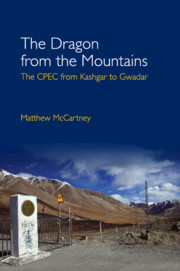Book contents
- Frontmatter
- Dedication
- Contents
- List of Maps and Figures
- List of Tables
- Preface
- Acknowledgements
- 1 Introduction
- 2 Big Infrastructure: Big Problems or Big Benefits?
- 3 CPEC Spillovers Rippling Outwards
- 4 Through the Eyes of Who? Evaluating the Success of the CPEC
- 5 The Dragon Uncoils: Special Economic Zones (SEZs) from Shenzhen to Africa
- 6 The Dragon's Embrace: Pakistan–China Trade Policy
- 7 The Will of the Dragon: The Importance of an Industrial Policy
- 8 Conclusion: The Way of the Dragon or the Way of the Falcon?
- Bibliography
- Index
1 - Introduction
Published online by Cambridge University Press: 06 August 2021
- Frontmatter
- Dedication
- Contents
- List of Maps and Figures
- List of Tables
- Preface
- Acknowledgements
- 1 Introduction
- 2 Big Infrastructure: Big Problems or Big Benefits?
- 3 CPEC Spillovers Rippling Outwards
- 4 Through the Eyes of Who? Evaluating the Success of the CPEC
- 5 The Dragon Uncoils: Special Economic Zones (SEZs) from Shenzhen to Africa
- 6 The Dragon's Embrace: Pakistan–China Trade Policy
- 7 The Will of the Dragon: The Importance of an Industrial Policy
- 8 Conclusion: The Way of the Dragon or the Way of the Falcon?
- Bibliography
- Index
Summary
The introduction first introduces and explains the China–Pakistan Economic Corridor (CPEC), what it is, how much it will cost and what its geographical contours and timewise evolution are. The introduction then places the CPEC into five important background contexts that will be referenced throughout the rest of this book. These are (a) the economic optimism the CPEC has generated in Pakistan; (b) the long friendship between China and Pakistan; (c) the economic development of Pakistan since 1947; (d) the evolution of China's political economy since the death of Mao in 1976; and (e) the global history of big infrastructure projects. Finally, the introduction summarises some of the key questions and findings of the chapters of the book.
WHAT IS THE CPEC?
The CPEC refers to a massive package of investment that has been promised to Pakistan. The investments are inspired by a bigger Eurasia-wide Chinese vision, that of the New Silk Road. This vision has subsequently become known as the Belt and Road Initiative (BRI). China has promised to provide much of the funding to Pakistan upfront, though controversy remains about whether, how and on what terms that funding will be repaid. The investments are concentrated in energy, transport infrastructure and the construction of special economic zones (SEZs) to promote industry. Map 1.1 shows some of the main projects of the CPEC. The nearly 3,000 kilometres (1,800 miles) of roads and rail from Kashgar in China to Gwadar in southern Pakistan can be clearly visualised. The CPEC includes oil and gas pipelines, railways, highways, SEZs and fibre-optic networks (Sial 2014).
The CPEC was initially projected to cost $46 billion, of which 71 per cent ($32 billion) was to be invested in energy, 8 per cent in rail, 13 per cent in road links and 4 per cent in the Gwadar port (Boyce 2017: 12). By 2017, this total had been raised to $62 billion. These numbers give a false impression of precision about the CPEC. As with the entire BRI project, it is difficult to pin the CPEC down, as Shafqat and Shahid argue, ‘Identifying and explaining the various components of the CPEC is a tedious and complex task because the information is not readily available, is scattered across sources or changes frequently’ (2018: 24).
- Type
- Chapter
- Information
- The Dragon from the MountainsThe CPEC from Kashgar to Gwadar, pp. 1 - 26Publisher: Cambridge University PressPrint publication year: 2021



